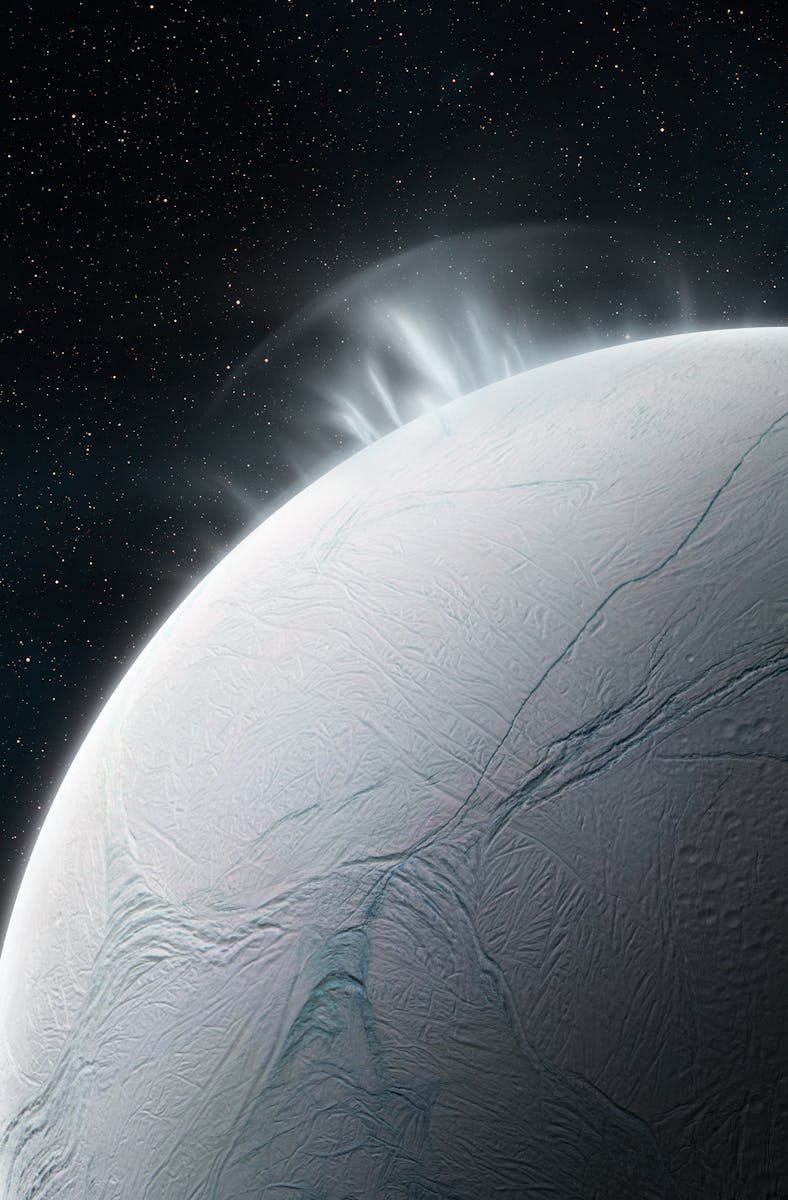These 17 Icy Worlds Could Have Warm Oceans Full of Alien Life
With any luck, we could one day watch chilly geysers erupting from the surface of nearby (and potentially life-sustaining) exoplanets.

Chilly alien oceans could lie hidden beneath miles of ice on planets like Trappist-1f, Proxima Centauri b, and LHS 1140 b. And if we’re lucky, we may be able to watch geysers of water erupt from cracks formed across their frozen landscapes.
According to a new study from planetary scientists at NASA’s Goddard Space Flight Center, 17 planets orbiting nearby stars could have frozen surfaces, but heating from deep within the planets’ interiors could keep oceans of water relatively cozy beneath the icy surface. These alien oceans could be similar to the ones found on Jupiter’s moon Europa and Ganymede as well as Saturn’s moon Enceladus — all places where the hunt for alien life in our own Solar System has recently focused its gaze. Similar to Europa and Enceladus, water may also erupt through cracks in the icy surface in huge, sparkling plumes that are so large they could be glimpsed by telescopes on (or near) Earth.
Lynnae Quick, a planetary scientist at the Goddard Space Flight Center, and her colleagues published their work in The Astrophysical Journal and presented it at last week’s American Geophysical Union annual meeting.
Plumes of water vapor and ice crystals erupt from cracks in the icy surface of Saturn’s moon Enceladus.
Life Beyond the Habitable Zone
To discover these 17 snowball worlds, Quick and her team combed through NASA exoplanet survey data, looking for alien planets that might be similar to Europa. Specifically, they wanted planets about the same size as Earth but less dense than our rocky little world. If a planet was less dense, the thinking goes, it just might have more of its inner layers made of water and ice.
The interiors of these Hoth-like planets, keep their liquid oceans warm in a couple of ways. First, radioactive elements deep inside the planet release tremendous amounts of heat as they decay. But Europa, for example, is also engaged in a gravitational tug-of-war with Saturn, which pulls at the planet’s interior in the same way that the Moon’s gravity pulls at Earth’s oceans. That constant motion has the convenient side effect of also keeping the planet’s interior warm.
In this study, Quick and her colleagues plotted each planet’s orbit and calculated how much tidal heating could warm up the planet’s interior. Then, they estimated each world’s surface temperature based on telescope data and began forming a picture of how much water might freeze from above (creating an icy crust) while melting from below (creating a liquid ocean).
Quick and her team discovered that 17 exoplanets looked a lot like some of the icy moons that orbit gas giants in our own cosmic backyard. Beneath miles of hard-frozen ice, liquid water churns. Geysers of water vapor — laden with grains of sand and organic molecules — erupt from cracks in the ice or ooze in slushy “cryolava” flows across its frozen, atmosphere-free surface. If Quick and her colleagues are right, the same things could be happening on many other planets, including some that we’ve long dismissed because they lie beyond the Goldilocks Zone — too far from their stars (and therefore too cold) for life.
“Searches for habitable environments should consider not only rocky exoplanets that lie in the stellar habitable zone but also the potential for habitable environments outside of the ‘Goldilocks Zone,’ even beyond the snow lines of exoplanetary systems,” the paper reads.
Astronomer’s Guide To Glimpsing Alien Geysers
Although theorizing about distant worlds helps us understand the universe, most astrobiologists want to actually see and measure evidence of liquid oceans on distant worlds, especially if they’re filled with the chemical building blocks for life. This study suggests astronomers could possibly find that evidence in the form of enormous geysers blasting into space through cracks in the ice. That’s because a few of the planets on their list, including Proxima Centauri b, our nearest interstellar neighbor, and LHS 1140b, a promising world six times as massive as Earth, both hold conditions where these geysers are possible.
Quick’s team estimated how much water each planet could blast out into space in the form of geysers based on its interior heat and the most likely depth of its ocean and thickness of its ice. The answer turned out to be a lot: more than 13 million pounds per second of water could erupt through Proxima Centauri b’s 190-foot-thick shell of ice. Proxima Centauri b, Trappist-1f, and LHS 1140 b are all close enough to Earth that telescopes like the James Webb Space Telescope (JWST) and Nancy Grace Roman Observatory could glimpse those massive geysers in action.
For worlds like Trappist-1f and LHS 1140 b, which cross in front of their stars from our point of view on Earth, finding those hypothetical geysers should be relatively easy. With the planet silhouetted in front of its host star, astronomers just need to look for a plume of gas that absorbs starlight in the same wavelengths as water vapor. It’s even possible that starlight filtering through those gigantic plumes could reveal chemicals essential for life.
On the other hand, Proxima Centauri b doesn’t transit its star, but Quick and her colleagues suggest that a powerful enough telescope could still measure the starlight reflecting off the planet’s surface. Water reflects light at specific wavelengths, and patches of material reflecting starlight at those wavelengths could reveal erupting plumes or flows of slushy “cryolava” on the planet’s surface. If these patches seem to appear and then disappear, then the presence of water plumes is even more convincing.
Earth is the only planetary example scientists have to work with when searching for life beyond within and beyond our Solar System, but studies like this show that warm, rocky worlds may not be the only life-sustaining formula at work in the universe.